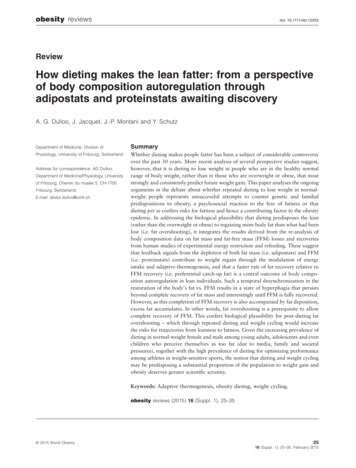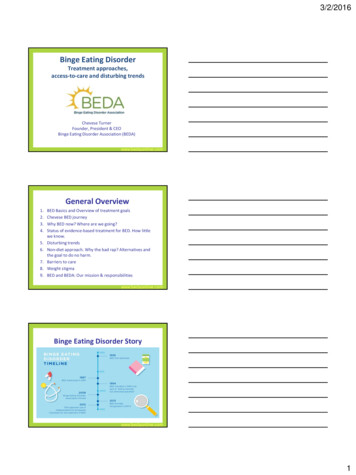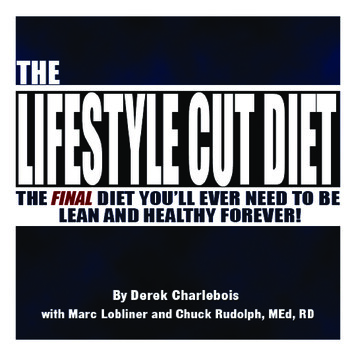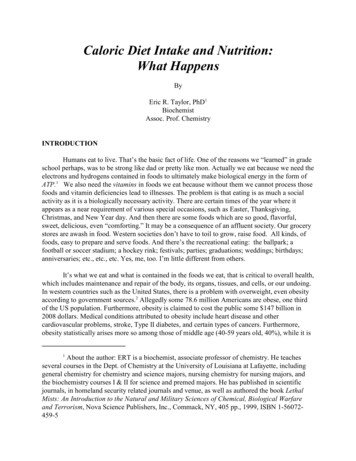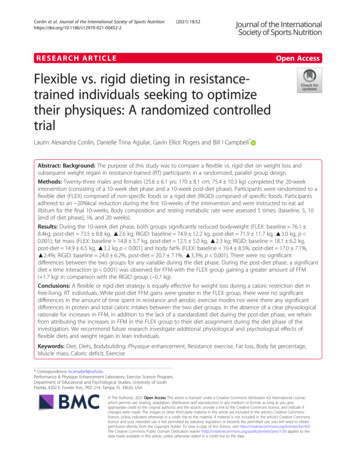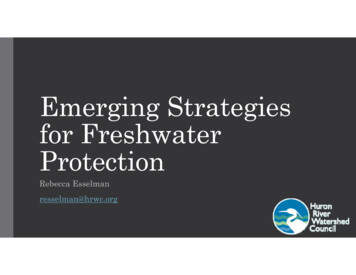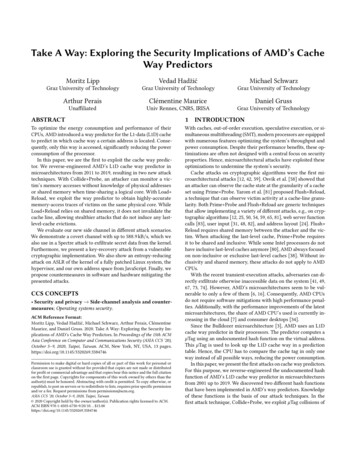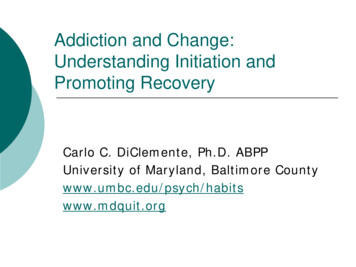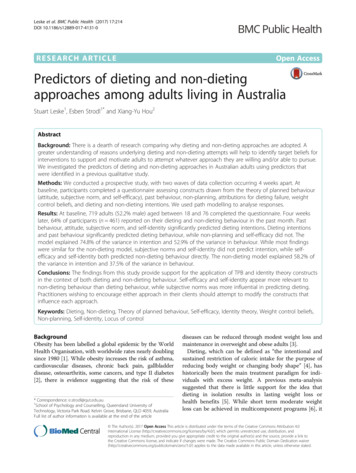
Transcription
Leske et al. BMC Public Health (2017) 17:214DOI 10.1186/s12889-017-4131-0RESEARCH ARTICLEOpen AccessPredictors of dieting and non-dietingapproaches among adults living in AustraliaStuart Leske1, Esben Strodl1* and Xiang-Yu Hou2AbstractBackground: There is a dearth of research comparing why dieting and non-dieting approaches are adopted. Agreater understanding of reasons underlying dieting and non-dieting attempts will help to identify target beliefs forinterventions to support and motivate adults to attempt whatever approach they are willing and/or able to pursue.We investigated the predictors of dieting and non-dieting approaches in Australian adults using predictors thatwere identified in a previous qualitative study.Methods: We conducted a prospective study, with two waves of data collection occurring 4 weeks apart. Atbaseline, participants completed a questionnaire assessing constructs drawn from the theory of planned behaviour(attitude, subjective norm, and self-efficacy), past behaviour, non-planning, attributions for dieting failure, weightcontrol beliefs, and dieting and non-dieting intentions. We used path modelling to analyse responses.Results: At baseline, 719 adults (52.2% male) aged between 18 and 76 completed the questionnaire. Four weekslater, 64% of participants (n 461) reported on their dieting and non-dieting behaviour in the past month. Pastbehaviour, attitude, subjective norm, and self-identity significantly predicted dieting intentions. Dieting intentionsand past behaviour significantly predicted dieting behaviour, while non-planning and self-efficacy did not. Themodel explained 74.8% of the variance in intention and 52.9% of the variance in behaviour. While most findingswere similar for the non-dieting model, subjective norms and self-identity did not predict intention, while selfefficacy and self-identity both predicted non-dieting behaviour directly. The non-dieting model explained 58.2% ofthe variance in intention and 37.5% of the variance in behaviour.Conclusions: The findings from this study provide support for the application of TPB and identity theory constructsin the context of both dieting and non-dieting behaviour. Self-efficacy and self-identity appear more relevant tonon-dieting behaviour than dieting behaviour, while subjective norms was more influential in predicting dieting.Practitioners wishing to encourage either approach in their clients should attempt to modify the constructs thatinfluence each approach.Keywords: Dieting, Non-dieting, Theory of planned behaviour, Self-efficacy, Identity theory, Weight control beliefs,Non-planning, Self-identity, Locus of controlBackgroundObesity has been labelled a global epidemic by the WorldHealth Organisation, with worldwide rates nearly doublingsince 1980 [1]. While obesity increases the risk of asthma,cardiovascular diseases, chronic back pain, gallbladderdisease, osteoarthritis, some cancers, and type II diabetes[2], there is evidence suggesting that the risk of these* Correspondence: e.strodl@qut.edu.au1School of Psychology and Counselling, Queensland University ofTechnology, Victoria Park Road. Kelvin Grove, Brisbane, QLD 4059, AustraliaFull list of author information is available at the end of the articlediseases can be reduced through modest weight loss andmaintenance in overweight and obese adults [3].Dieting, which can be defined as “the intentional andsustained restriction of caloric intake for the purpose ofreducing body weight or changing body shape” [4], hashistorically been the main treatment paradigm for individuals with excess weight. A previous meta-analysissuggested that there is little support for the idea thatdieting in isolation results in lasting weight loss orhealth benefits [5]. While short term moderate weightloss can be achieved in multicomponent programs [6], it The Author(s). 2017 Open Access This article is distributed under the terms of the Creative Commons Attribution 4.0International License (http://creativecommons.org/licenses/by/4.0/), which permits unrestricted use, distribution, andreproduction in any medium, provided you give appropriate credit to the original author(s) and the source, provide a link tothe Creative Commons license, and indicate if changes were made. The Creative Commons Public Domain Dedication o/1.0/) applies to the data made available in this article, unless otherwise stated.
Leske et al. BMC Public Health (2017) 17:214is often regained over time, although some studies lackthe long-term follow-up necessary to document thisweight regain [7]. Nonetheless though the magnitude ofweight loss and weight loss maintenance potentially maybe small, without interventions, individuals tend tocontinue to gain weight over time [8].During the 1990s, the dieting or weight-centred paradigm was criticised for its inability to achieve long-termweight loss [9, 10]. More recently criticisms of this paradigm have also included that it contributes to food andbody preoccupation, eating disorders, lower self-esteem,weight cycling and weight stigmatisation [11–13]. Inresponse an alternative non-dieting paradigm hasemerged which focuses instead on body acceptance, andhealth behaviours and outcomes, without a focus onweight loss [14]. Other non-dieting tenets includedeating intuitively (i.e., relying on internal hunger andsatiation cues) rather than dietary restriction [15], andenjoying physical activity in contrast to participating instructured exercise [14]. A review of six randomisedcontrolled trials involving non-dieting approaches foundclinically and statistically significant improvements inblood lipids, blood pressure, body image, eating disorderpathology, physical activity, mood, and self-esteem [14].No weight gain was observed following any of thenon-diet interventions. Given that approximately 30–40% of weight-concerned adults report trying to manage weight using what may be regarded as a diet [16, 17],a non-dieting intervention is potentially an alternativeapproach for those interested in health but not interestedin weight loss.Currently little is known about why individuals chooseto adopt non-dieting approaches, and how this is similarto or different from the reasons why individuals choosedieting approaches. A greater understanding of this willhelp to identify target beliefs for interventions to supportor motivate adults to attempt whatever approach theyare willing and/or able to pursue. This study comparedand contrasted predictors of dieting and non-dieting toprovide a greater understanding of what constructsuniquely predict each approach and how an individualmight transition from one approach to another.Literature reviewTo address the dearth of research comparing and contrasting these approaches in an adult Australian population, this study aimed to empirically test the associationbetween choosing a dieting or a non-dieting approachand a range of psychological constructs that had beenassociated with this choice in a previous qualitativestudy we conducted [18]. Because there appeared to be astrong overlap between some of the constructs identifiedin this qualitative study and the Theory of Planned Behaviour (TPB), this study involved a core TPB methodologyPage 2 of 18supplemented by additional psychological constructs fromthe qualitative study and wider literature. These constructs included identity [19], influential others [20], outcome expectations [21, 22], attributions for dieting failure[18, 20], non-planning and self-efficacy [18], and beliefsabout whether to focus on weight or lifestyle [18, 23].Theory of planned behaviourThe Theory of Planned Behaviour (TPB) is a social cognitive theory comprising attitudes, subjective norms andperceived behavioural control. Attitudes are consideredto be positive or negative evaluations of behaviour; subjective norms are thought of as perceptions of socialpressure to perform behaviour; while perceived behavioural control refers to a general perception of controlover behaviour. These concepts purportedly influenceintentions and intentions influence behaviour.In the context of dietary behaviour, the TPB has beenused previously to predict consumption of a low-fat diet[24, 25] and dieting [26–28]. In the dieting studiesintention has emerged as the only predictor of dietingbehaviour [26], while attitudes, prior dieting, indirectperceived control (beliefs underlying the direct measureof perceived behavioural control), and descriptivenorms (perceptions of what others do) predicted dieting intentions and dieting behaviour [27, 28]. A recentmeta-analysis of the TPB’s application to the prospective prediction of health behaviours suggested that thetheory more efficaciously predicted dieting behaviourthan risk detection, safe sex, and drug abstinencebehaviours [29].Self-identitySelf-identity has been proposed as a useful addition to theTPB [30]. Originating from identity theory [31, 32], selfidentity is conceptualised as an individual’s salient aspectof self that is related to certain behaviour [33]. These rolesare conceptualised with reference to wider society [34],meaning that self-identity can reflect several social rolesthat individuals fulfil [31, 32]. Stryker proposes that individuals behave in a manner consistent with their identity,progressively more so as this identity becomes moresalient. Self-identity has previously predicted dieting intentions [35], low-fat diet consumption [24], low animalfat diet [36] and actual healthy eating behaviour [37]. Arecent meta-analytic review of the inclusion of selfidentity in TPB studies [30] supports its additive effects;regression analyses indicated that self-identity explainedon average an incremental 6% of the variance in intentionafter controlling for the TPB constructs.ImpulsivityTwo recent studies have augmented the TPB by including impulsivity-related measures capturing non-
Leske et al. BMC Public Health (2017) 17:214reflective information processing. In two prospectivestudies, impulsivity significantly predicted avoidanceof snacking after TPB constructs were controlled for,explaining an additional 10% [38] and 6.9% [39] ofvariance and an additional 6.9% of variance. Individuals higher in impulsivity were more likely to snackin both studies. The relevance of impulsivity to dieting behaviour is evident in qualitative studies suggesting that diets are adopted with a quick fix inmind [20] while non-dieting approaches appear to beadopted with a longer-term perspective in mind [18].Locus of control measuresBased on previous qualitative studies [18, 20], domainspecific locus of control beliefs concerning diet adherence and weight control appeared relevant to predictingdieting and non-dieting behaviour. Originating fromRotter’s social learning theory [40–42], locus of controldescribes the degree to which individuals perceive theycan control events. These perceptions are either internal(contingent on one’s behaviour or characteristics) or external (determined by luck, chance, fate, or the environment) [43]. Failing to adhere to a diet might be internal(e.g., lacking discipline), external (e.g., diet expense orrestrictiveness), or somewhere along this continuum.Previous reasons for diet nonadherence include the dietbeing “unrealistic”, “unsustainable”, or “too expensive”,although self-blaming has also been noted [20]. It hasbeen observed qualitatively that blaming diets precipitatednon-dieting attempts [18]. Accordingly, we measuredattributions for dieting nonadherence in this study.Weight control beliefs can also distinguish between dieters and non-dieters [18, 23]. Laliberte and colleagues[23] have conceptualised these as “beliefs that you canand should control your weight” (BCWeight) and beliefsthat “you should strive for a healthy lifestyle and acceptthe resulting weight” (BCLifestyle). Both items representa high internal locus of control – with BCWeightpresumably underpinning a dieting approach, and BCLifestyle presumably underpinning a non-dieting approach. Strong endorsers of weight control beliefs weremore likely to be involved in restricted eating and bingeeating, as well as also distinguishing between patientswith eating disorders and non-patients [23]. Conversely,individuals in a non-clinical sample strongly endorsingbeliefs in a healthy lifestyle had a lower risk of bothrestrained and binge eating.Aims and hypothesesIn light of the literature above, we had one main research question: (1) What are the determinants ofdieting and non-dieting intentions and behaviours?Drawing from the TPB model, we hypothesised thatmore positive attitudes towards dieting (attitudes), morePage 3 of 18perceived social pressure to diet (subjective norms) andmore confidence in dieting (self-efficacy) would predictdieting intentions and dieting behaviour. We hypothesised that non-dieting attitudes, non-dieting subjectivenorms and non-dieting self-efficacy would predict nondieting intentions and non-dieting behaviour. Althoughwe measured perceived control, it was omitted due tolow internal reliability ( .60), the salience of self-efficacyin our qualitative findings [18], previous literature [24, 25]and the presence of other domain-specific measuresaddressing internal and external control (weight controlbeliefs, dieting adherence beliefs).For self-identity, we hypothesised that seeing oneselfas the type of person who diets, is concerned with theirweight, or sees themselves as overweight would predictdieting intentions and behaviour, while seeing oneself assomeone who eats healthily without dieting would predictnon-dieting intentions and behaviour. We hypothesised adirect link between self-identity and behaviour based onprevious research [44] and theoretical predictions thatidentity may represent more impulsive, unplanned routesto engaging in a behaviour [45, 46]. Based on our previousfindings, we hypothesised that scoring higher on the impulsiveness sub trait of non-planning reflecting “presentorientation” or “lack of futuring” [47] would positivelypredict dieting intentions and behaviour, while scoringlower would negatively predict non-dieting intentions andbehaviour. We expected that individuals high in nonplanning impulsiveness would be inclined to quickly formintentions to diet to achieve short-term goals. Wereasoned that there might be a direct link betweennon-planning and behaviour through a more spontaneous pathway. Specifically, individuals’ weight lossgoals, coupled with widespread marketing of structured diets promoting weight loss [48], could result inimpulsive adoption of a diet without deep consideration. Given our prospective design, some adults maynot have formed an intention to diet at baseline yetdecided to diet after completing the baseline questionnaire. Because some diets have extensive, well-designedplans available online [49], these diets would suit someonehigh on non-planning who felt unable or unwilling to planthemselves. Conversely, we considered eating healthywithout dieting a more deliberative behaviour adoptedwith long-term goals in mind and so we speculatedthat this would be intended and actually adopted byindividuals lower in non-planning impulsiveness. Fordieting adherence, we hypothesised that attributingfailure of a diet to oneself would reinforce dietingintentions, while attributing dieting failure to thediet would predict non-dieting intentions. Weexpected that BCWeight would positively predictdieting intentions while BCLifestyle would positivelypredict non-dieting intentions.
Leske et al. BMC Public Health (2017) 17:214MethodsParticipantsWe required that participants were aged 18 and overand living in Australia. Because most non-dieting studieshave included overweight or and obese female participants [50], some recruitment strategies focused exclusively on males. Because normal weight adults alsoattempt to lose weight [51], they were eligible for inclusion in this study since the topic of dieting was evidentlyapplicable to them and so they could serve as a referencegroup for overweight and obese adults in the analyses.ProcedureWe obtained ethical clearance for the study from theQueensland University of Technology’s Human ResearchEthics Committee. We recruited a community-basedsample through snowball sampling, media releases, articles in newsletters and newspapers, notices at the localhealth clinic, radio broadcasts, public venues (voting hallon election day), and the newsletters of various smallbusinesses with an interest in food and health. Snowballsampling was implemented to access community members not affiliated with universities and to ensure thatthe sample size obtained was sufficiently powered forthe planned statistical analyses. Prior to participatingonline, participants viewed an information sheet informing them of the voluntary nature of consent and outlining their right to withdraw from the study at any time.Participants were subsequently informed that beginningthe questionnaire indicated that they had consented totaking part in the study.We used a prospective shortitudinal study design toenable temporal ordering and conclusions about prediction to be drawn. Australian adults subsequently completed a baseline questionnaire (see ‘Additional file 1:questionnaires.docx’) consisting of a demographics section, items assessing predictors derived from the TPB(attitude, subjective norm, and self-efficacy), and itemsassessing self-identity, attributions for dieting failure,weight control beliefs, and non-planning. Four weekslater, the Time 2 questionnaire (see ‘Additional file 1:questionnaires.docx’) assessed participants’ self-reporteddieting and non-dieting behaviour in the past month.Time 1 and Time 2 questionnaires were matched via acode identifier. At Time 1 and Time 2, participants weregiven the opportunity to enter a prize draw to win oneof three iPad Minis, each valued at AUD 315. Wecollected data between June and November 2013.MeasuresDependent variablesThe target behaviours, ‘dieting’ and ‘non-dieting’, wereboth adapted from a definition from the National TaskForce on the Prevention and Treatment of Obesity [4] inPage 4 of 18their review of the behavioural effects of dieting in obeseadults. Items were developed with the same level ofspecificity in terms of the target (weight loss and/orchanging body shape), action (dieting), time (in the nextmonth), and context (in any situation), as recommendedby Fishbein and Ajzen [52]. We did not state specificdurations for the behaviours because we considered thatthese items measured attempts at each approach (e.g.,[24]), and so we were unconcerned with adherence. Wespecified that dieting is:“Intentionally restricting your calorie intake (energy orkilojoules derived from food) or increasing certain typeof foods (e.g., high carbohydrate or high protein) to loseweight and/or change your body shape.”We added the phrase “increasing certain types of foods(e.g., high carbohydrate or high protein)” since someweight loss diets (e.g., the Paleo Diet) are based on eating certain types of foods to promote satiety withoutrestricting or counting calories. Participants were furtherinstructed that dieting did not include fasting for religious purposes, since this was not a weight loss attempt.We further clarified that dieting could include any eatingprogram planned by someone else, or any approach anindividual had designed on their own, to use in anycontext, so long as participants intended to lose weightand/or change their body shape. Participants were provided with examples of popular diets (e.g., The PaleoDiet or The Pritikin Diet), commercial weight loss programs (e.g., Weight Watchers or Jenny Craig), or mealreplacements (e.g., Tony Ferguson or OptiSlim). Thisbroad operationalisation was necessary to ensure thatparticipants were certain whether they were dieting ornon-dieting, because we could not clarify this definitiononce participants began the survey online. A clear definition was important since one-item unambiguous questions assessing dieting are more strongly associated withreported energy intake than more general single-itemquestions (e.g., “doing anything to lose weight”) [53].Dieting and non-dieting were measured by askingparticipants to respond to the questions: “I am currentlydieting” and “I am currently eating healthily withoutdieting”, scored on a 7-point Likert scale ranging from 1(definitely not) to 7 (definitely). We did not dichotomisethis variable as a yes/no response format to accommodate people who may have made brief attempts at eitherand because of brevity not considered themselves dietingor non-dieting. Although the dieting definition has beenused previously and is considered valid [53], the latterdefinition was adopted for this study and broadly represented non-dieting. Because dieting often involves externalrules and regulations regarding eating, the opposite of thiscould be reliance on hunger and internal cues (i.e., intuitive eating; [15, 54, 55]). However, other non-dieting concepts and programs including competent eating [56],
Leske et al. BMC Public Health (2017) 17:214Page 5 of 18mindful eating [57], and the Appetite for Life Program[58] also fit under the umbrella of non-dieting approachesand so we adopted this broader non-dieting conceptualisation so long as it disavowed dieting methods and objectives. We assumed that non-dieting approaches wouldfocus on eating healthily. This wider conceptualisationwas consistent with the broad definition of selfreported dieting also defined by its objective (weightloss). Assessing non-dieting as the absence of dietingwould not consider the focus on healthy eatingemphasised by non-dieting advocates, while measuringnon-dieting with a question solely concerning healthyeating would not explicitly convey an approach thatdisavowed dieting methods and objectives. Therefore,‘eating healthy without dieting’ meant eating healthywithout intentionally restricting caloric intake or eating certain types of foods for the purposes of losingweight and/or changing body shape. At Time 2, thesemeasures correlated negatively (r .35, p [one-tailed] .01), indicating that they were not consideredcomplete opposites by participants and there was tosome degree conceptual overlap (because diets wouldpresumably encourage healthy eating too). To confirmthat participants had interpreted these questions correctly,we asked participants at Time 2 four individual items toascertain to what extent they had, in the past month:‘changed their eating to lose weight’, ‘changed their eatingto alter their body shape’, ‘restricted their calorie intake’and ‘eaten healthily’. We used Spearman’s rho correlations(Table 1) because data appeared non-normal.Independent variablesMost items were assessed using a 7-point Likert scale. Thenon-planning subscale measuring impulsivity used a 4point Likert-type scale since the scale has been validatedusing this response format [59], while the attitudinal measures used a semantic-differential format (e.g., good-bad).Items with negatively worded endpoints were reversescored and recoded so the scale endpoints reflected positiveor higher attributes of the construct. Items were averagedTable 1 Convergent and discriminant validity for dieting andnon-dieting items (n 450)ItemsNon-dieting dependent Dieting dependentvariablevariableRestricted calorie intake in -.24**the past month.71**Changed eating to lose-.26**weight in the past month.74**Changed eating to alterbody shape in the pastmonth-.23**.69**Eaten healthily in thepast month.55**.07* p .05 (1-tailed), ** p .01 (1-tailed)to create scale scores for cases with (at least) twothirds of the scale items completed. For the nondieting items, the words ‘diet/dieting’ were substitutedwith the words ‘eat/eating healthily without dieting’.TPB constructsDue to survey space constraints and because multipleitem intention measures often display Cronbach’salphas .90 [60], a single-item measure of intention wasused for each behaviour. Consistent with previous studies [27], one item each assessed participants’ intention todiet or non-diet: “I intend to diet/eat healthily withoutdieting in the next month”, ranging from 1 no, definitelynot to 7 yes, definitely. One item each assessed pastbehaviour: “I dieted in the past month” or “I ate healthilywithout dieting in the past month”. Based on a previousstudy [28], five items assessed attitudes towards dietingand non-dieting (10 items in total): “dieting/eatinghealthily without dieting in the next month would be 1harmful to 7 beneficial; 1 pleasant to 7 unpleasant; 1foolish to 7 wise; 1 bad to 7 good; 1 ineffective to 7effective. We substituted unenjoyable-enjoyable forineffective-effective because previous literature suggestedthat the effectiveness of a diet is a key attitudinal consideration [20]. Two injunctive items and one descriptiveitem assessed subjective norm: “Most people who areimportant to me think that I (should not/should) diet/eat healthily without dieting”; “It is expected of me that Iwill diet/eat healthily without dieting” and; “People whoare important to me diet/eat healthily without dieting”,ranging from 1 no, definitely not to 7 yes, definitely. Twoitems drawn from a previous study [24] assessed self-efficacy: “How confident are you that you will be able todiet/eat healthily without dieting in the next month?”ranging from 1 not confident at all to 7 very confident,and “I believe I have the ability to diet/eat healthilywithout dieting in the next month” ranging from 1 no,definitely not to 7 yes, definitely.Self-identity assessed how participants’ self-conceptinfluenced their intentions to diet or non-diet. Based onfindings of the prior qualitative study [18], we assesseddieting self-identity with three items: “I think of myselfas someone who is concerned with my weight”, “I thinkof myself as a dieter”, and “I think of myself as an overweight person”, all ranging from 1 no, definitely not to 7yes, definitely. For non-dieting, self-identity was assessedwith two items: “I think of myself as a healthy eater”,and “I think of myself as someone who eats healthilywithout dieting”, both ranging from 1 no, definitely notto 7 yes, definitely. The non-dieting self-identity was atwo-item scale because thinking of oneself as a “normalweight” person (in contrast to an overweight person)was not apparent in the previous qualitative study [18].Although self-identity is usually operationalised using
Leske et al. BMC Public Health (2017) 17:214the same language for each question, the qualitativestudy suggested that this terminology clustered together,the internal consistency of the self-identity items supported this conceptualisation and previous studies applying self-identity in this context have used differentlanguage that could cluster together, such as healthyeating and pleasures of eating [24].Weight control beliefs were measured with the WeightControl Beliefs Questionnaire [23], a 17-item, two-factorscale capturing two sets of beliefs: Beliefs that “you canand should control your weight” (BCWeight) and beliefsthat “you should strive for a healthy lifestyle and acceptthe resulting weight” (BCLifestyle). BCWeight consistsof beliefs that underlie weight control significant positiveassociations with disturbed eating, body dissatisfactionand poor self-esteem, whereas BCLifesyle assesses beliefsunderlying non-dieting and has a strong protective relationship against these outcomes [23]. Laliberte et al. [23]have successfully discriminated between eating disordered and non-eating disordered individuals using thescales. These scales were validated in this study throughexamining correlations with theoretically related subscales in both dieting and non-dieting models. In thisstudy, BCWeight was positively and significantly correlated with all measures assessing dieting in the dietingmodel. Conversely, BCLifestyle was significantly andpositively related to all measures assessing non-dietingin the non-dieting model. No measure capturing attributions for diet adherence failure could be located in theliterature so we measured this with a 1-item scale informed by the qualitative findings and invented for thisstudy: “If I was not able to stick to a diet, it would be ”ranging from 1 my fault, 4 my fault and the diet’s faultto 7 the diet’s fault”. A two-item measure would havebeen preferable but we concluded that a midpoint proportioning the blame between the individual and the dietwould adequately represent the construct. In support ofthis, this measure of dieting failure had a medium-tolarge correlation with beliefs that you can and shouldcontrol your weight at r .47 (p .01) and a mediumsized correlation with positive attitudes towards dietingr .33 (p .01), which we would expect given that blaming yourself rather than a diet would maintain positiveattitudes towards dieting. Finally, we measured the personality/behavioural construct of impulsivity using the 5item non-planning subscale of the Barratt ImpulsivenessScale – Version 11 [60].In terms of moderators, self-reported height and weightwere used to calculate body mass index (BMI) by dividingweight in kilograms by height in metres squared. BMI categories were calculated by recoding the continuous BMIvariables into normal weight (BMI between 18.5 and 24.99),overweight (BMI between 25 and 29.99) and obese (BMI 30or more) categories. Due to sample size considerations, dataPage 6 of 18from overweight and obese participants were run togetherand compared to normal weight adults.Please see the Additional file 1 for the full questionnaireused in this study.Statistical procedureWe used path modelling in IBM SPSS AMOS 21.0.0 [61]to test hypothesised relationships. We used the maximumlikelihood (ML) estimation method to test the models andbootstrapped for robust standard errors and corrected teststatistics when non-normality appeared. We evaluatedoverall model fit using the χ2 test and the “normed” χ2statist
RESEARCH ARTICLE Open Access Predictors of dieting and non-dieting approaches among adults living in Australia Stuart Leske1, Esben Strodl1* and Xiang-Yu Hou2 Abstract Background: There is a dearth of research comparing why dieting
